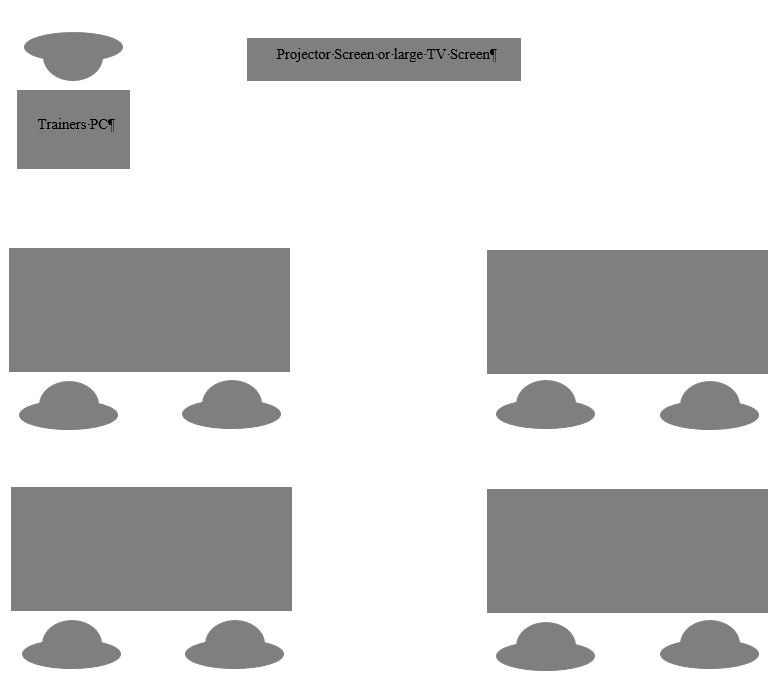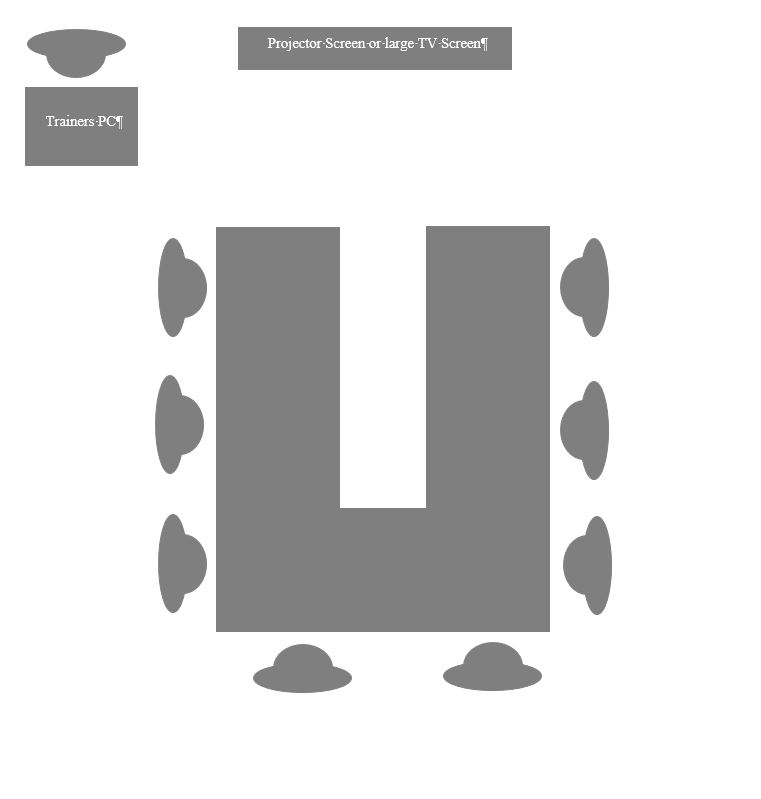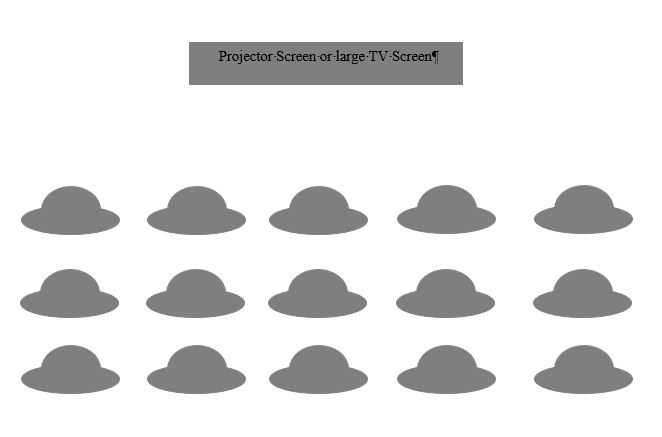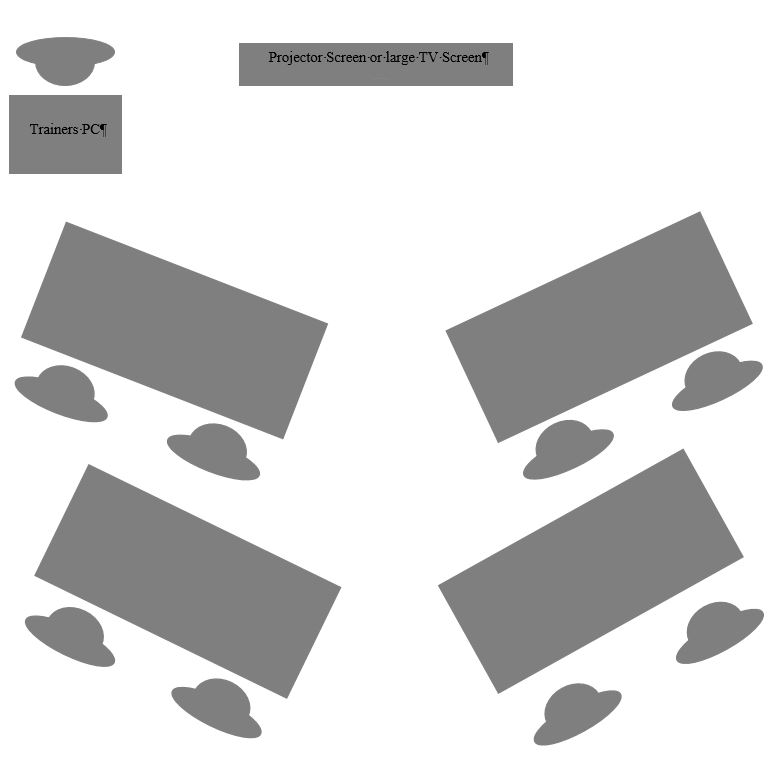Its a good idea to think early as part of your transformation or training programme how and where you are going to train your employees on their new software.
Possible solutions might include one or a combination of the following:
- e-learning
- classroom training (onsite)
- classroom training (offsite)
- mobile training bus or pod
- 1 to 1 or shadowing/coaching
- drop in location for people to have a play or ask questions
- large demonstrations (showing large number of people small snippets of the functionality)
Once you have started to think about how you might conduct some of your training you may want to look at if or how you may be able to facilitate running internal training courses at your premises.
There are a number of different room layouts you may want to consider. Each will have some elements for them and some against them and you will probably also be restricted by the size and shape of the room and other factors including the position of electrical sockets, doors and windows.
There is no right or wrong layout but here we will look at some of the possible layouts you could choose from if you are looking at running your classroom training in-house.
Classroom Style Layout:

Pros:
- Will often ensure each delegate has enough room for their computer, monitor, keyboard, mouse and somewhere to write notes or place their training reference material.
- As long as the room is big enough it should allow for the trainer and/or subject matter expert to walk around the room to ensure delegates are following along with demonstrations and are not getting left behind during exercises.
- Delegates are not facing each other so may be advantageous to ensure better concentration.
- If there are sockets locate don the left and right walls this is a good layout to ensure cables are not a trip hazard.
Cons:
- Delegates in the left and right corners and in rows further back may have difficulty seeing the television screen or projection screen.
- Delegates may need to twist to interact with their peers or to interact with their trainer or floorwalker.
- May be harder to get to a blank wall or flipchart to post it note car park questions or participate in icebreakers.
Horseshoe/U Style Layout:

Pros:
- Helps promote interaction between delegates as most of the delegates are facing each other as long as their monitors are not blocking their view.
- If all sockets are located at the top of the room cables can be neatly contained in the centre of the horseshoe/U. You would need to secure cabling where delegates, trainers and floorwalkers may need to walk in front of the television or presentation screen.
Cons:
- Being opposite other delegates may be distracting.
- Delegates may find themselves too far away from the television or presentation screen.
- May be difficult to get to any blank walls for ice breakers or to post it note car park questions.
Consider using to:
- Train trainers, subject matter experts, super users and end users that will to use the new system extensively.
- For courses where you are mixing demonstrations with practical exercises and want delegates to ask questions and interact with each other.
- Enable you to use the wall space to encourage delegates to move around during the course by car parking questions using post it notes on the wall during the course.
- Add additional flip charts to facilitate brainstorming exercises or icebreakers
Theatre Style Layout:

Pros:
- Good for large groups who may be coming in for a short presentation/demonstration session perhaps to see the software for the first time or for very low use volume users
- Needs limited computer equipment, power and desks.
Cons:
- No facility for delegates to make notes or to practice using the software
- Visibility may be poor for delegates to the far left, far right or towards the rear of the room
- Some delegates may need to turn to see the television or projection screen.
Consider using to:
- Useful where you have lots of low use users as an educational piece. This can be supported further with floor walking or remote support when you go live if they are not customer facing users.
- Beneficial if you want to include some staggered demonstrations throughout your software implementation to help staff feel included in the process.
- Can be used to show key stakeholders the progress made to date in the rollout.
Variations to consider:
- Change the angle of the desks to forn a chevron shape.
- Change the angle of the desks to form a semi circle.
Chevron or V Layout:

Pros:
- There may be some increased visibility for delegates seated at the far left or right desks
- There may be an opportunity to slightly stagger the desks to enable delegates in the second row to see the television or presentation screen clearly.
- Cables can be kept to the left and right if electricity sockets facilitate this as long as the left and right are not used for delegates, trainers or floorwalkers to move up and down the room.
Cons:
- Interaction between peers may be limited as people in the rows to the rear of the room will be facing the backs of people on the front row.
- Some delegates may need to twist to face the trainer or floorwalker.
- It may be harder for people to walk around the room.
Consider using to:
- Train internal trainers, super users, subject matter experts (SME’s) and high volume software users.
- Provide delegates with classroom training which offers a mix or demonstrations and exercises.